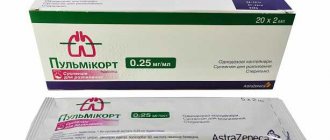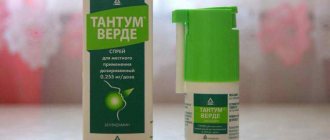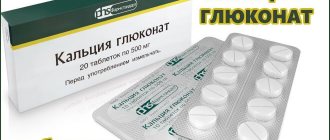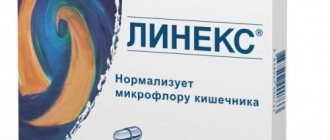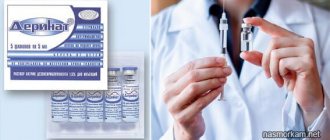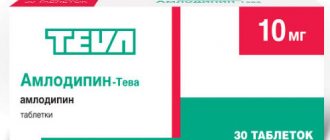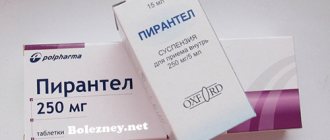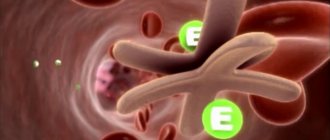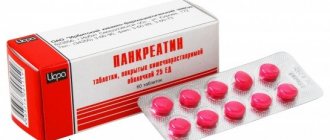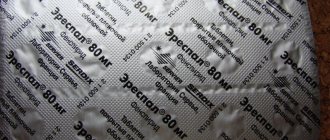Eufillin tablets, the instructions for use of which state that this is a drug for systemic use, can cure respiratory tract diseases (obstructive). Eufillin tablets have strong diuretic, antispasmodic, bronchodilating and tocolytic properties on the human body, thanks to which the treatment of respiratory pathologies is carried out in a short time. The drug in tablets is prescribed by the doctor after a complete examination of the patient and identification of the disease. To quickly get rid of the symptoms of upper respiratory tract diseases, you should take Eufillin tablets strictly according to the instructions that are in each pack, and also follow the advice of a medical professional so that the treatment proceeds without serious complications.
pharmachologic effect
Eufillin (intravenously and for intramuscular administration) has a diuretic, antispasmodic, tocolytic and bronchodilator effect on the body. The injection solution helps with pathologies accompanied by obstruction of the respiratory tract. Intramuscular aminophylline can be considered a medicine for systemic use.
The principle of action of Eufillin in ampoules is based on the ability of the drug to block adenosine (purine) receptors of bronchial cells and accelerate the accumulation of cyclic adenosine monophosphate in them. With regular use, there is a decrease in the rate of entry of calcium ions through the channels of cell membranes and a decrease in muscle contractile activity.
Therapeutic effect of Eufillin:
- improvement of alveolar ventilation;
- stimulation of breathing;
- increased sensitivity of the respiratory center;
- improving the activity of the respiratory and intercostal muscles;
- increase in mucociliary coefficient;
- stimulation of diaphragm contractions;
- relaxation of the bronchi.
The drug can be used for apnea: the medication normalizes breathing, provides an influx of oxygen and reduces the concentration of carbon dioxide. The medication is able to stimulate the activity of the heart muscle, normalizing the frequency of its contractions. Accelerates blood microcirculation, reduces tension in the walls of blood vessels.
Diuretic properties manifest themselves as an increase in the volume of blood flow in the kidneys. Eufillin in ampoules dilates the bile ducts, improves the rheological properties of blood and minimizes the risk of blood clots. The tocolytic effect manifests itself in the form of a decrease in contractility and excitability of the myometrium. When using Eufillin in high doses, an epileptogenic effect is observed.
When it enters the systemic circulation, the active component is 60% bound to plasma proteins. Metabolism is carried out by the liver. The half-life is 3-6 hours. Excreted by the kidneys or intestines (partially).
Composition and release form
The drug Eufillin is available in solid and liquid dosage forms.
The solid form of Euphyllin is tablets with the main active ingredient aminophylline 150 mg.
The liquid dosage form of Eufillin is represented by injection solutions of two types:
- 24% solutions of Euphyllin for intramuscular administration (1 ml), with the amount of the main active ingredient aminophylline 240 mg;
- 2.4% solutions of Eufillin for intravenous infusion (5 ml, 10 ml), with the amount of the main active ingredient per 1 ml of 24 mg.
Important: injection solutions of the drug are not interchangeable!
Indications and contraindications for use
The instructions included in each box of Euphyllin contain possible contraindications and indications for use. The medication is prescribed for the following pathologies:
- left ventricular failure (bronchospasm, Cheyne-Stokes type breathing);
- prolonged migraines;
- pulmonary hypertension;
- cerebrovascular insufficiency of the brain;
- broncho-obstructive syndrome due to emphysema, cardiac asthma or bronchitis.
The main contraindications are:
- severe liver and kidney diseases;
- sepsis;
- porphyria;
- hyperthyroidism;
- thyrotoxicosis;
- uncontrolled hypothyroidism;
- gastroesophageal reflux;
- increased threshold of convulsive readiness;
- epileptic seizures;
- ulcerative lesions of the stomach and duodenum (in the acute stage);
- hemorrhages in the retina;
- bleeding (history of gastric, intestinal);
- hemorrhagic stroke;
- vascular atherosclerosis;
- pulmonary edema;
- severe arterial hypertension;
- paroxysmal hypotension;
- tachycardia;
- extrasystole;
- angina pectoris;
- myocardial infarction;
- acute heart failure;
- individual intolerance to the active ingredient or additives.
The high risk of side effects makes it impossible to use Eufillin in children under 14 years of age. Lactation and pregnancy are considered relative contraindications. For children under 3 years of age, the solution is not administered into a vein. Droppers with Eufillin for osteochondrosis dilate blood vessels, helping to relieve a pain attack. Regardless of the form of release, the drug can be taken for bronchial asthma.
Eufillin during pregnancy
Eufillin is prescribed to pregnant women for health reasons in the absence of a threat to the life of the mother and child. According to reviews, a pregnant woman's heart rate increases, dizziness and weakness appear.
Children who are in the womb of a mother who was prescribed Eufillin in the last trimester should be under medical supervision for the first 28-30 days after birth. In gynecology, the drug is used for edema, placental insufficiency and gestosis as part of complex therapy. There is no clear treatment regimen; the attending physician selects the dosage individually.
Reviews
I suffer from suffocation, so the doctor prescribed me Eufillin. Thanks to this drug, I can breathe fully and enjoy life. The effect occurs literally five minutes after taking it, now I carry the pills in my purse constantly in order to stop the attack in a timely manner.
Ekaterina, 28 years old, Tver
I used Eufillin to treat bronchitis, it became easier and more free to breathe, and I was able to quickly get rid of phlegm. I was constantly bothered by coughing attacks at night, so I could not sleep normally and disturbed my relatives. After using the pills, my life improved, there were no side effects.
Ivan, 46 years old, Kaluga
Eufillin: instructions for use in ampoules
Many people are interested in the question of whether the drug can be taken in ampoules. Experts do not recommend taking the solution orally. Eufillin can be administered intramuscularly and intravenously. The medication may be present in microenemas and inhalation solution.
Intramuscular injection
No more than 1 ml of the drug is administered intramuscularly to the patient once. The tip of the ampoule is carefully broken off, the solution is drawn into a sterile syringe and excess air is released. For injections, thick and long needles are considered the most suitable: thin ones are difficult to remove from the muscle, they constantly slide off the holder. The drug is injected into the upper corner of the buttock. The injection of Eufillin is painful; discomfort can persist for several hours. A hematoma often forms at the injection site. The medicine is not administered subcutaneously.
Intravenous administration
Intravenous administration ensures faster absorption of the active ingredient. Patients in serious condition are given a single loading dose of the drug: up to 5.5 mg/kg. To prepare a dropper, up to 20 ml of Eufillin is injected into a solution of sodium chloride (0.9%, 15-20 ml). The resulting mixture is poured into the remaining saline solution (up to 500 ml), drip administration is carried out for 30-40 minutes.
Status asthmaticus requires intravenous administration of up to 720 mg of aminophylline. The daily norm is no more than 0.5 ml/kg. For an adult patient, a single patient dose (provided that the solution is injected into a vein) is 6-7 mg/kg. The drug must be diluted with sodium chloride. The duration of the jet injection is 2-4 minutes.
Adolescents are prescribed medication at a dose of 16 mg/kg per day. It is advisable to divide the therapeutic norm into several administrations. If necessary, it can be increased with the permission of a specialist. The course of treatment is 10-14 days.
Administration by probe
For newborn children in serious condition, the drug is administered through a nasogastric tube. A narrow bore catheter is passed through the nasal cavity into the stomach. A Levine catheter is most often used to administer the drug. The probe is installed by an appropriately qualified medical professional. The dosage regimen is selected by the pediatrician.
Microclysters
You can prepare a microenema with Eufillin yourself, at home. To do this, you need to take 0.5 mg of the drug and dissolve it in 20 ml of boiled water at room temperature. The prepared solution is drawn into a rubber bulb (the tip is disinfected in advance) and administered rectally. The procedure is repeated every 3-4 hours. Enemas are contraindicated in children under 16 years of age.
Electrophoresis
Electrophoresis using the drug is prescribed for adults suffering from osteochondrosis and arthritis. For children, the procedure is prescribed for dysplasia or to relieve intracranial pressure. Electrophoresis allows you to achieve the desired concentration of the main component in the affected tissues.
The medication has a targeted effect, so systemic side effects rarely occur. Electrophoresis is prescribed to newborn children over 30 days old. A napkin soaked in the solution is placed on the sore spot and the electrodes are secured. The duration of the procedure does not exceed 15 minutes, during which time the medicine penetrates into the affected areas. The course of treatment is 8-10 sessions.
To restore the functional activity of internal organs after birth injuries, newborns undergo Ratner electrophoresis. The child is given 2 napkins soaked in different medications: 1 - aminophylline solution (on the cervical vertebrae), 2 - papaverine solution (on the ribs). Current strength: no more than 2 mA. Duration: 15 minutes. The procedure has virtually no contraindications, except for skin diseases, arterial hypertension, arrhythmia and heart failure.
Inhalations
Inhalations with Eufillin are prescribed to adults and children for bronchial obstruction and dry cough. The active component quickly penetrates the systemic bloodstream and reaches the affected organ. The procedure is carried out using a special device - a nebulizer. Eufillin diluted in warm water is poured into a special compartment. The released vapors must be inhaled for 10 minutes. The procedure is repeated 2 times a day.
How to enter
Eufillin solution, according to the instructions for use, must be administered parenterally into a vein in the following dosage:
- newborns up to 90 days - 30-60 mg per day;
- infants under one year old - from 60 to 90 mg;
- from 12 to 36 months - 90-120 mg per day (Eufillin intravenously);
- from 4 to 7 years - 120-140 mg per day;
- for children from 8 to 16 years old, the daily dosage is increased to 250-500 mg;
- Adolescents over 16 years of age and adults are given injections or droppers with Aminophylline at the rate of 6 mg of aminophylline per 1 kg of body weight.
The drug is diluted in 10-20 ml of saline, after which it is slowly injected into a vein. If tachycardia and nausea develop, a dropper is placed, for which aminophylline is mixed with 100-150 liters of a solution of 0.9% sodium chloride. The feed rate varies from 30 to 50 drops/min. The children's solution for intravenous administration is not given in full daily dosage, but is divided into 2-3 doses.
The course of therapy lasts 2 weeks.
For status asthmaticus, it is recommended to place a dropper for 1-2 hours with a 30 ml solution of the drug diluted in 250 ml of saline.
Is it possible to inject intramuscularly?
Aminophylline can be injected intramuscularly by adults in a daily dosage of 100-500 mg of aminophylline. For children, the daily intake is determined at the rate of 15 mg of the active ingredient per 1 kg of weight. The medication is administered 3-4 times a day. This method is chosen if the patient for any reason cannot take aminophylline tablets.
What do you think are the most important factors when choosing a medical facility?
For intramuscular injection, select the upper outer quadrant of the buttocks. Before using the product, the skin is treated with alcohol. The injection is painful, but the drug is not mixed with painkillers.
Is it possible to drink
The drug for injection can be taken orally, but it is not recommended to drink Eufillin solutions. If you take the drug orally, there will be no therapeutic effect, that is, the medicine will not work.
For treatment, it is necessary to use tablets coated with a protective coating. It will not allow the active compound to be destroyed by hydrochloric acid and will ensure its absorption into the blood in the small intestine.
Side effects and overdose
Side effects occur when the dosage regimen is incorrectly selected. These include:
- tachypnea;
- chest pain;
- flushed face;
- increased sweating;
- hematuria;
- frequent urge to urinate;
- albuminuria;
- hypoglycemia;
- fever;
- rashes on the skin;
- itching;
- loss of appetite;
- change in taste preferences;
- exacerbation of ulcers;
- uncontrollable vomiting;
- heartburn;
- pain in the epigastric region;
- diarrhea;
- attacks of nausea;
- uncontrolled angina pectoris;
- decreased blood pressure;
- cardialgia;
- cardiopalmus;
- arrhythmia;
- sleep disorders (drowsiness/insomnia);
- tremor;
- psycho-emotional overexcitation (anxiety, aggression, irritability);
- dizziness;
- headache.
Ailments are often dose-dependent, so experts recommend that if side effects occur, adjust the dosage regimen downward.
Symptoms of overdose develop with a multiple increase in the daily dose. The characteristic features are:
- convulsions, sensitivity to light or sound;
- tremor;
- arrhythmia;
- overexcitement;
- hyperemia of the skin;
- uncontrollable vomiting;
- prolonged diarrhea.
Eufillin does not have a specific antidote. A patient who experiences symptoms of overdose must be taken to the nearest medical facility: gastric lavage and taking enterosorbents will not help in this case. Removal of toxins is carried out by enhancing the processes of natural detoxification (formed diuresis).
If the dose introduced into the body exceeds 0.5 mg/ml, then the patient is provided with respiratory support (artificial ventilation), hemodialysis, hemosorption and plasmapheresis are performed. A physician should monitor hemodynamic parameters. If the patient experiences convulsions, Diazepam is administered intramuscularly. Barbiturates are strictly prohibited.
Indications for treatment
Eufillin is recommended if the patient has chronic obstructive pulmonary disease, asthma, bronchitis, or apnea. It is used to reduce high intracranial pressure, to eliminate asthma attacks, and in case of impaired blood circulation in the brain, which develops with strokes and brain swelling.
Eufillin injections intravenously are prescribed if the patient develops heart failure in acute or chronic form. Such injections lower pressure in the blood vessels of the lungs and relieve swelling in kidney disease. The medicine helps with neuralgia (as does Milgamma and its substitutes). It is used in gynecology when there is a risk of premature birth or when there is a threat of miscarriage. It has a relaxing effect on the smooth muscles of the uterus and relieves spasms.
Contraindications of the drug
Eufillin is synthetic in nature and has a number of contraindications for which it should not be used:
- It is not recommended to give aminophylline injections for heart attacks, arrhythmias, and tachycardia.
- They are not used for epilepsy attacks, gastrointestinal ulcers (acute phase), or gastritis.
- Treatment with an injection solution should not be carried out if the patient has severe liver or kidney diseases, or there is a risk of hemorrhage in the retina.
- It is forbidden to take it if you are intolerant to aminophylline.
special instructions
A toxic effect develops if the concentration of the main component in the blood reaches 0.03 mg/ml. Eufillin has a stimulating effect on the respiratory system only if the content of the substance in the blood does not exceed 0.01 mg/ml. Children under 3 years of age and elderly patients require careful use; medication for this category of patients is prescribed as a last resort.
The drug can be used in geriatrics: it is prescribed in minimal doses. During the treatment period, experts recommend completely avoiding drinks containing caffeine and taurine. Chocolate and strong black hare should be excluded from the diet. Before injection, you need to hold the syringe with the solution in your hands for a little while so that it warms up.
Alcohol compatibility
The drug has negative compatibility with alcohol. Before starting treatment, the patient is instructed to completely stop drinking drinks that contain ethanol.
Interaction with other drugs
Beta-blockers, caffeine, ephedrine and Furosemide can enhance the effect of Eufillin, so these components are rarely combined. The therapeutic activity of the drug is reduced by Carbamazepine, Sulfinpyrazone, Rifampicin, Isoniazid, Phenobarbital and Phenytoin, so the dose of the bronchodilator is increased. In patients who smoke more than 15-20 cigarettes per day, accelerated metabolism of Eufillin is observed.
With the simultaneous use of antiviral medications, beta-blockers, Disulfiram, Fluvoxamine, Viloxazin, Lincomycin, Cimetidine, Isoprenaline, Allopurine, macrolide antibiotics with Euphyllin, the therapeutic dose of the latter should be increased. If the patient is prescribed a bronchodilator in combination with fluoroquinolone antibiotics, the dose of Eufillin is reduced by 25%.
Hypoglycemia develops with the combined use of diuretics, glucocorticosteroids and medications with a bronchodilator effect. Eufillin enhances the therapeutic effect of anticoagulants. Solutions of levulose, glucose and fructose are incompatible with the medication. The drug can only be diluted with sodium chloride.
Drug interactions
Increases the likelihood of developing side effects of glucocorticosteroids, mineralocorticosteroids (hypernatremia), general anesthesia (increases the risk of ventricular arrhythmias), xanthines and drugs that excite the central nervous system (increases neurotoxicity), beta-agonists. Antidiarrheal drugs and enterosorbents reduce the absorption of aminophylline. Rifampicin, phenobarbital, phenytoin, isoniazid, carbamazepine, sulfinpyrazone, aminoglutethimide, oral estrogen-containing contraceptives and moracizine, being inducers of microsomal liver enzymes, increase the clearance of aminophylline, which may require an increase in its dose. With the simultaneous use of macrolides with antibiotics, lincomicin, allopurinol, tsimetidine, isoprenaline, ennoxacin, small doses of ethanol, disulfate, fluoroquinolones, recombinant interferon alpha, methotrexate, mexyletin, thiabendazole, thyclopidine, verapamyl flu vaccination intensity of aminophylline may increase, which may require a reduction in its dose. Enhances the effect of beta-adrenergic stimulants and diuretics (including by increasing glomerular filtration), reduces the effectiveness of lithium preparations and beta-blockers. Compatible with antispasmodics, do not use in combination with other xanthine derivatives.
Analogs (briefly)
The drug has several generics with similar therapeutic effects. These include:
- Theotard. Available in capsule form. The composition contains theophylline, a xanthine derivative. It has a bronchodilator effect, quickly eliminating obstruction of the bronchial canals. Cost - 180-195 rubles.
- Teopek. Release form: tablets. The main component is a phosphodiesterase inhibitor, a purine derivative. Due to the ability of the medication to have a vasodilating effect, blood flow in the kidneys increases, and the smooth muscles of the bronchi relax. Price - from 200 rub.
- Aerophyllin. The active ingredient is doxophylline. The drug is marketed in tablet form. The antispasmodic can have a bronchodilator effect. The contractile function of bronchial smooth muscle tissue decreases with systematic use. Cost - 122 rubles.
- Neophylline. Extended-release tablets contain theophylline. A bronchodilator is able to improve the functional activity of the respiratory and intercostal muscles. Price - 55 rub.
The drugs are in different price categories. Each of them has a number of contraindications, so medications are prescribed by a doctor after a detailed examination. Independent choice of medication is strictly prohibited.
Side effects of Eufillin
After taking the medicine, patients may experience anxiety and insomnia. They feel dizzy, their limbs cramp, and muscle tremors begin. At the same time, the work of the heart muscle is disrupted, and heart palpitations begin. After the injections, a migraine occurs, the patient is agitated and quickly becomes irritated.
If a woman is pregnant, rapid heartbeat and arrhythmia may occur when taking the medicine in the last months of pregnancy. In addition, angina develops and blood pressure rises. With a long course of treatment with aminophylline, appetite may decrease, nausea may occur, and there may be attacks of vomiting. Sometimes the drug provokes diarrhea or the development of stomach and duodenal ulcers.
- Side effects can manifest themselves in the form of a skin rash, a person has a fever, and itching appears.
- Pain in the sternum may develop, diuresis increases, and the person sweats profusely.
- Often, simply reducing the dose of the medication is enough to reduce the side effects that occur.
- After the skin is punctured, this area may hurt and swell. There are compactions and swelling there.
Overdose: symptoms and assistance to the patient
After administering too large a dose of medication, appetite worsens, diarrhea develops, vomiting blood occurs, and nausea occurs. After an overdose, tachycardia may begin and internal gastric bleeding may develop. Problems with sleep may arise, convulsions and tremors in the limbs begin, photophobia and tachycardia develop.
When the dose is increased, the patient may become agitated, have epileptic attacks, develop hypokalemia, and drop blood pressure. The person often experiences confusion and kidney failure.
To stop the symptoms and improve the condition, it is necessary to discontinue the drug. The patient's stomach is washed, laxatives and activated charcoal are given. Symptomatic treatment is also carried out with metoclopramide and ondansetron if the patient vomits. For convulsions, oxygen therapy with airway support is recommended.
For epileptic seizures, the patient must be given an intravenous injection of diazepam. If a person vomits severely, intravenous injections of metoclopramide and ondansetron should be administered.
Application nuances
The medicine should be used with caution for heart attacks, angina pectoris, and atherosclerosis. Under the supervision of a doctor, treatment is carried out for renal and liver failure, for stomach or gastrointestinal ulcers. Treatment should be monitored for hypothyroidism, thyrotoxicosis, and prostatic hypertrophy. Popular We eliminate pain after injuries and operations with Artrosilene injections
The drug should be used with caution to treat the elderly and children. This is especially true when taking pills.
A reduction in dosage may be necessary if there is a dysfunction of the liver, with chronic alcohol dependence, if a person has a fever, or with an acute respiratory disease. Dose reduction is possible when treatment is prescribed to an elderly person. If an analogue of a drug with the same active substance is chosen, then regular tests should be carried out to determine its concentration in the blood.
- During treatment, you should not drink strongly brewed tea and coffee, or take theophylline and purine derivatives.
- Do not combine the drug with beta-blockers.
- It is not recommended to give injections if you are driving a car or other machinery. The ingredients of the drug, being absorbed into the blood, distract attention, and the severity of reactions is lost.
How to replace Eufillin
In pharmacy chains you can find only one synonymous drug - Aminophylline-Eskom. In addition, Eufillin has analogs that also belong to the group of bronchodilators, but contain other active ingredients. These include:
- Theophylline (in the form of tablets and rectal suppositories);
- Diprophylline (tablet and injection forms);
- Theobromine;
- Teofedrine-N;
- Theotard.
Since Eufillin is most often prescribed to pregnant women for gestosis, high blood pressure and edema, the drug can be replaced with medications aimed specifically at combating these pathological conditions.
Medicines substitutes for Eufillin for expectant mothers - table
| Name | Dosage forms | Active ingredients | Indications | Contraindications | Features of use during gestation |
| Theotard | capsules | theophylline |
|
| Not recommended in the third trimester due to the possibility of weakening labor. |
| Canephron N |
|
|
|
| Prescribed by a doctor after carefully weighing the possible risks. |
| Chime |
| dipyridamole |
|
| Allowed during gestation, but in the later stages it is taken with caution. |
| Askorutin | pills |
|
|
| Prohibited in the first trimester, allowed for use in later periods. |
| Verapamil |
| verapamil hydrochloride |
|
| The instructions do not recommend taking the drug during gestation, however, many years of practice have shown the effectiveness of the drug during pregnancy. |
Analogs of Eufillin - gallery
Theotard is a bronchodilator Curantil is a drug that dilates the coronary vessels Verapamil is often prescribed for gestosis Canephron N is used to get rid of edema Ascorutin is prescribed for gestosis and high blood pressure
Pharmacokinetics
When the drug is taken orally, it is rapidly absorbed from the gastrointestinal tract. The degree of absorption depends on the dosage: the higher the dose, the slower the absorption. The acidity of gastric juice increases. The rate of absorption may be reduced by food.
The maximum effect from using the medication is achieved after 2 hours. It is able to cross the placenta and into breast milk. The drug is metabolized in the liver and excreted from the body in the urine.
Is it possible for expectant mothers to take Eufillin?
Manufacturers in the annotation for the drug warn that the active substance can penetrate the placental barrier and accumulate in the child’s plasma. In addition, the use of aminophylline in late gestation often results in potentially harmful concentrations of theophylline in the blood of the newborn.
Reviews from doctors regarding the use of Eufillin during pregnancy are contradictory
Many doctors are against prescribing Eufillin to pregnant women, considering it an outdated and potentially harmful drug. As an argument, they cite the fact that the diuretic effect of the drug can disrupt the water-salt balance, and this is just as dangerous for the expectant mother’s body as edema.
However, doctors of the “old school” continue to recommend the medication, citing many years of experience in its use in obstetric and gynecological practice. Indeed, with severe gestosis, Eufillin is able to quickly help a woman, eliminating the dangerous condition.
Thus, before prescribing the drug, the doctor assesses all possible risks and threats, takes into account the severity of symptoms, the trimester of pregnancy (the first trimester is prescribed extremely rarely), as well as the health status of the expectant mother and child.
If Eufillin was nevertheless prescribed, certain rules must be followed:
- It is better to take medication treatment in a hospital, since it is necessary to regularly examine the woman and the fetus;
- the drug cannot be used for a long time (usually symptomatic therapy for swelling is indicated for expectant mothers);
- It is worth minimizing the dosage (as much as possible).
The American Food and Drug Administration has assigned aminophylline, the active substance of Euphyllin, category C. It follows that animal experiments have established a negative effect of the drug on the embryo. And yet, the likely benefits of using the medication for serious indications justify the numerous risks.
Use of the drug
Eufillin can be prescribed not only for the treatment of bronchitis.
Due to its properties, it allows you to effectively take the necessary measures when:
- heart disease;
- Bladder;
- gallbladder.
When using the drug to relieve a patient from signs of bronchitis, the following occurs:
- Reducing coughing attacks.
- Good discharge of sputum and mucus.
- Relieves bronchospasms.
- Makes breathing easier during attacks.
Eufillin is also used to treat bronchitis in patients who smoke a lot and do not quit this bad habit even during an exacerbation of the disease.
If a sudden attack of suffocation occurs, the drug can help the patient, and this happens very quickly. It is used to treat people with bronchial asthma. But for this you need to provide urgent help. This medicine is available in the form of injection ampoules and tablets. This allows the patient to always have the necessary medicine with him.
Another method can also be used. In this case, electrophoresis is done with Eufillin. Even small children can be treated this way.
An exacerbation of bronchitis affects the airways anywhere. But the disease can occur due to dust or foreign objects. In this case, the patient will experience difficulty in exhaling and inhaling. Eufillin is able to provide real help to the patient in this case. But take it only as prescribed by a doctor.
We recommend reading! Follow the link:
How does acute bronchitis manifest and what means to treat it
What can happen when mixing
All contraindications of aminophylline, the active substance found in the drug with the trade name Euphyllin, are associated with its ability to interact with other chemicals and increase its effect on humans:
- Alcohol significantly increases the concentration of aminophylline in all body fluids.
- The drug, intended to stimulate respiratory and vasomotor processes, when mixed with ethanol, actively stimulates the frequency and strength of heart contractions, causing tachycardia.
- The respiratory system always suffers from an overdose of the active substance.
- The smooth muscles of the bronchi relax so much that a person may completely lose the ability to breathe, and then rehabilitation measures will not help him.
- With weak blood vessels, cerebral hemorrhage may occur, because the active substance helps to dilate the blood vessels in the brain.
- Very often, after taking one pill while drunk, patients feel severe weakness due to a sharp change in blood pressure.
How to use the drug during pregnancy
Doctors noted that, if necessary, Eufillin can be used by pregnant women. It will not have a negative effect on the health of the unborn baby. The medicine can cause unpleasant symptoms in the mother in the form of nausea, vomiting and severe intoxication. However, this will not affect the child's health in any way.
Doctors prescribe Eufillin to pregnant women in the following cases:
- In the treatment of gestosis;
- If the pregnant woman begins to experience severe swelling;
- For the treatment of placental insufficiency;
- If the mother's health is at risk and the drug must be used.
You should not be afraid of taking Eufillin during pregnancy. If the doctor prescribed it for treatment and prescribed a specific dosage, then you don’t have to worry. However, if a woman experiences any complications or side effects of the drug, she should immediately inform the doctor.
What can happen when mixing
All contraindications of aminophylline, the active substance found in the drug with the trade name Euphyllin, are associated with its ability to interact with other chemicals and increase its effect on humans:
- Alcohol significantly increases the concentration of aminophylline in all body fluids.
- The drug, intended to stimulate respiratory and vasomotor processes, when mixed with ethanol, actively stimulates the frequency and strength of heart contractions, causing tachycardia.
- The respiratory system always suffers from an overdose of the active substance.
- The smooth muscles of the bronchi relax so much that a person may completely lose the ability to breathe, and then rehabilitation measures will not help him.
- With weak blood vessels, cerebral hemorrhage may occur, because the active substance helps to dilate the blood vessels in the brain.
- Very often, after taking one pill while drunk, patients feel severe weakness due to a sharp change in blood pressure.
Electrophoresis of the cervical spine with aminophylline
For better penetration of the substance into the deep structures of the neck, you can use electrophoresis with Eufillin on the cervical spine. It is used in cases where hernias and osteochondrosis are detected. Electrophoresis is also effective for infants.
What is the electrophoresis technique? Several electrodes are applied to the cervical spine, containing the required dosage of Eufillin. A small current is applied. The drug applied to the electrodes moves under the influence of an electric field and penetrates into the necessary structures, in particular the skin.
The very effect of electric current already has a positive therapeutic effect, it is especially effective in relieving edema, and when combined with the administration of Eufillin, this effect is enhanced.
A significant advantage of administering Euphyllin using electrophoresis is that the drug does not affect other organs, but acts locally at the site of application and penetration, where its maximum concentration is created.
Contraindications
- individual hypersensitivity,
- high or vice versa low blood pressure,
- myocardial infarction in the past, existing heart rhythm disturbances,
- hereditary disease - hypertrophic cardiomyopathy,
- epilepsy,
- pulmonary edema,
- kidney and liver failure,
- stroke (especially hemorrhagic),
- pregnancy and lactation period. The properties of Eufillin include the ability to pass through the membranes of the placenta into the child’s body, creating in it such a concentration that turns out to be dangerous and even destructive. Also, the medicine passes into the mother’s milk, and, again, into the child’s body, which is dangerous for him.
Poisoning or overdose
When too high a dose of the drug is consumed or administered intravenously or intramuscularly, signs of overdose appear. A person experiences anxiety attacks, sleep disturbances, nausea, vomiting with blood, intestinal or stomach bleeding, arrhythmia, facial swelling, increased sensitivity to light, or seizures. In this case, you should immediately call an ambulance. In case of severe poisoning, the patient falls into a coma.
Instructions for use of Pantogam in tablets and syrup
To relieve seizures, diazepam is used (barbiturates are prohibited), and detoxification is carried out by stimulating the kidneys and natural elimination of the toxin. In this case, plasmapheresis, peritoneal dialysis, hemodialysis, and hemosorption are prescribed. During the process, hemodynamic parameters are monitored.
Pharmacokinetic properties
Aminophylline is metabolized in the human body at physiological pH values to release free theophylline. The bronchodilating property is manifested at concentrations of theophylline in the blood in the range of 10-20 mcg/ml. Concentrations greater than 20 mg/ml are considered toxic. The stimulating effect on the respiratory center is realized at lower concentrations - 5-10 μg/ml.
The binding of the main element to plasma proteins is approximately 40%; in newborns, as well as in adults with certain pathologies, the level of binding decreases. In adult patients, plasma protein binding is approximately 60%, in newborns - 36%, in people with cirrhosis - 36%. The substance penetrates the placenta (the level in the fetal blood is slightly higher than in the mother's blood) and into mother's milk.
Theophylline undergoes metabolic processes in the liver with the participation of several cytochrome P450 isoenzymes, the most important of which is CYP1A2. Metabolic changes produce 1,3-dimethyluric acid, as well as 3-methylxanthine and 1-methyluric acid. These metabolites are excreted through the urinary system. In adult patients, approximately 10% of the main component is excreted unchanged. In newborns, a significant portion is excreted in the form of caffeine (due to the immaturity of the pathways for its subsequent metabolism), approximately 50% in unchanged form.
Serious individual differences in the rate of hepatic metabolism of theophylline are considered the main reason for the pronounced variability in clearance, blood concentration, and half-life. The process of hepatic metabolism is influenced by factors such as smoking addiction, age, dietary preferences, diseases, and concomitant drug therapy.
The half-life of theophylline in non-smoking patients with bronchial asthma with almost no pathological changes in other systems and organs is 6-12 hours, in people with a smoking addiction - 4-5 hours, in childhood - 1-5 hours, in the neonatal period and in premature babies - 10-45 hours. This interval increases in older people and in people suffering from liver disease or heart failure.
Clearance decreases with liver dysfunction, heart failure, pulmonary edema, chronic alcoholism, COPD. Ethylenediamine does not affect the pharmacokinetic properties of theophylline.
Is it possible to use Eufillin intramuscularly? It is important to find out in advance
Some facts
Due to poor ecology, poor nutrition and weak immunity, many people have recently been exposed to severe respiratory diseases.
The organs of the respiratory system - the bronchi and lungs - are the first to be affected. Most broncho-obstructive diseases begin with an inflammatory process that has a negative effect on the lining of the lungs. Children and elderly people with weak bodies are especially vulnerable to this pathology. Inflammations occur due to pathogens, viral infections, allergies, or inhalation of toxic air saturated with gases and chemical compounds. At the first manifestations of broncho-obstructive syndrome, you should immediately seek help from a medical facility. Based on the results of the examination, the patient will be prescribed productive drug treatment that will eliminate the cough reflex and other signs of the disease.
https://www.youtube.com/watch?v=ytaboutru
Eufillin is a medicinal drug intended for systemic use in the treatment of obstructive pathologies of the bronchopulmonary apparatus. It is endowed with highly effective antispasmodic, diuretic, and bronchodilator effects.
The medicine is a xanthine derivative, which is presented as a phosphodiesterase inhibitor. It helps to increase cyclic adenosine monophosphate in soft tissues, reduce calcium ions entering through cell membrane pathways, and block adenosine receptors. In addition, the active substance of the drug is aimed at reducing the contractile activity of smooth muscles.
Features of the use of aminophylline for bronchial asthma
Intravenous administration of the drug is carried out subject to certain conditions:
- before use, the medicine must be heated to human body temperature;
- begin administration with a minimum dosage, gradually increasing it;
- the drug is not diluted with glucose solution;
- During administration, strict monitoring of the patient's blood pressure and pulse is necessary. If they change, it is necessary to reduce the rate of administration;
- when administering large doses, monitor the content of Euphyllin in the blood. If necessary, the dosage of the medication is reduced.
When treating bronchial asthma with a drug, you should refrain from carrying out work that requires maximum concentration of attention, as well as from driving vehicles.
